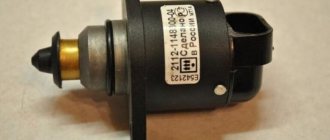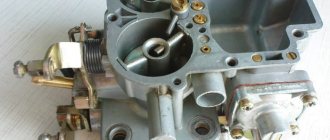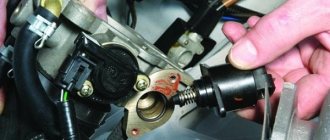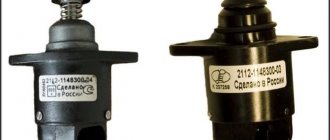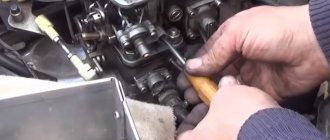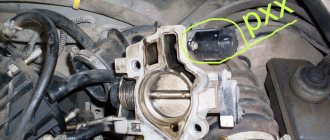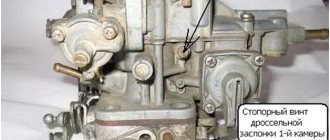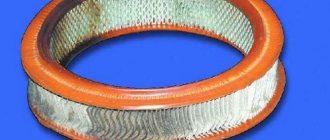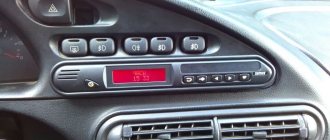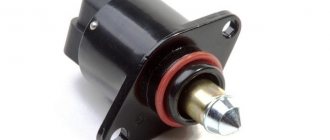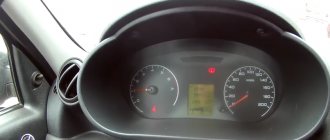How does the regulator work?
In everyday life, the IAC is often called a sensor, although in reality it is not one. The element is a stepper motor housed inside a non-separable housing. Only the spring-loaded rod with a cone-shaped tip protrudes outward. At the command of the ECU, the engine extends or retracts the rod to a certain distance.
The idle speed sensor is located in the throttle valve block, the working cone is extended into a small cross-section bypass channel. Since the engine starts and idles without pressing the accelerator pedal, the mentioned channel supplies air to the cylinders when the throttle is closed. The task of the IAC is to regulate the amount of air flow, blocking part of the flow area with a cone.
To better understand the issue, it is worth presenting the operating principle of the idle speed sensor in the form of an algorithm:
- After the driver turns on the ignition, the controller activates the governor motor, forcing the idle air passage to open. The ECU calculates the opening amount using a temperature sensor - if the engine is cold, the rod will move back more.
- At the moment of startup, the injectors supply an enriched mixture to the cylinders. Then the amount of fuel is reduced so that the engine does not “suffocate” and stall. The speed is monitored by the control unit using a crankshaft position sensor.
- The volume of air entering through the IAC is taken into account by the mass air flow sensor located on the inlet pipe, while increased crankshaft speeds are maintained (1200–1500 rpm).
- Using the temperature sensor, the control unit “sees” that the engine is warming up and gradually reduces idle speed, giving the command to the IAC to cover the cross-section of the bypass channel. When the temperature reaches an acceptable value (60 °C or more), the regulator maintains the speed at 850 rpm.
Note. If a warm engine is started, the controller immediately sets the IAC (IAC) rod to the operating position corresponding to normal idle speed.
Common causes of floating revolutions
So, we figured out the main symptoms. Now let's move on to the reasons. Let us immediately note that floating idle speed is often a problem with injection engines. The fact is that a complex ECM system is responsible for idling in this case.
This system assumes the presence of a controller, sensors and actuators. The control unit receives signals from sensors and transmits commands to actuators (for example, IAC), maintaining stable engine speeds at idle and other modes, regardless of the load on the internal combustion engine.
However, any failures that are associated with the supply of air, fuel, a violation of the composition of the working fuel-air mixture or its ignition, as well as various mechanical breakdowns will lead to floating speed.
- As a rule, in practice, the idle air regulator causes a lot of problems for drivers. In fact, this is a stepper motor that has a conical locking needle. When the throttle valve is closed, air bypasses the valve through a channel that is closed by the needle.
If malfunctions occur in the operation of the device, the ECU is not able to correctly “select” the mixture composition at idle, as a result, the speed floats.
- The mass air flow sensor also deserves special attention. During operation, the air flow sensor may become dirty or break down.
How to check the idle air control - accessories
Checking the idle air control valve is not a complicated process, so doing it yourself will not be difficult. We can offer at least two approaches, for the first you will need a special device - a multimeter. First, turn off the ignition and disconnect the harness from the IAC. After this, the resistance on all windings of the regulator is checked using a multimeter.
The resistance should be as follows: between windings C and B, as well as A and D - open circuit, and between C and D, A and B - 40-80 Ohms.
You can also make a device for checking resistance yourself, using a 6 V AC transformer. We check the IAC strokes, alternately using switches. A bright light indicates that the idle air control valve needs to be cleaned. For this procedure, you only need carburetor cleaner and WD-40.
Eventually
The F14D4 engine has many advantages. This includes an improved timing belt that lasts a long time, a high-quality pump, and the absence of an EGR valve. The crankcase ventilation is well thought out, allowing gases to escape from the throttle area. Therefore, the damper rarely becomes dirty, which is a big advantage for an electronic drive. It is also easy to replace the oil filter on this engine - this is done from above, without a hole.
This is where the advantages end. Fragile intake manifold that can break easily. Poor traction at the bottom. The performance of the oil heat exchanger installed under the exhaust manifold is not impressive. The seal on it often breaks and antifreeze gets into the oil. Low-grade fuel easily damages the catalyst - it is made integral with the exhaust manifold.
Definitely, the manufacturer has eliminated some previous errors of the F series engine, but new ones have been added.
Source
Causes and symptoms of IAC problems
There are a number of problems that can lead to a malfunction of the IAC Lancer 9:
- natural wear and tear of the stepper motor;
- disruption of the electricity supply;
- contamination of the rod and cone;
- ECU breakdowns, which can also be determined by excessive fuel consumption, difficult operation of the power plant, and so on.
Diagnosing a sensor failure yourself is not that difficult. It is enough to start the car and remove the connecting socket from the block. If there is no problem with the regulator, the speed will drop and the engine will stop.
Signs of a regulator malfunction include:
- unstable operation of the engine, it stalls, during a cold start the crankshaft speed does not increase;
- if you turn on the headlights or use the car’s electrical system, the idle speed drops;
- when changing speed, the engine periodically stalls;
- a spontaneous increase and decrease in speed is noticeable.
You can find the fault either independently, by conducting a thorough inspection, or by contacting specialists at the service center.
In addition, failure codes also report problems; they look like this:
- P1509 - the control circuit is overloaded;
- P1513 - a short to ground has occurred;
- P1514 - there are problems with the power supply, insufficient power.
In such cases, the root of the problem is often hidden in the wiring. Test codes can be obtained by using a scanner, and they can be decrypted using special tables available on the network.
Ways to eliminate the “sore”
How to fix the problem? For this we only need a screwdriver. Let's begin the procedure.
- By disconnecting the terminal block and also unscrewing two screws, we dismantle the assembly.
- We notice that traces of rust inside interfere with the movement of the wheel that regulates the position of the damper.
- We fill the insides of the defective device with a penetrating anti-rust aerosol.
- Use a development screwdriver to turn the wheel.
- We reassemble in reverse order.
Check to see if the engine idle speed is now high. The problem should go away.
Now let's look at another case. Let's say we have high idle speed in a VAZ 2114. This is what we do when faced with this situation.
When clarifying the circumstances of the problem under investigation, we always initially check the operation of the idle speed sensor. This device consists of a needle built inside an electromagnetic coil. The needle either moves inside the coil, moving away from the hole in the throttle pipe, or moves out, closing this hole, thereby stopping the supply of air for combustion of the mixture.
Also read about adjusting engine idle speed and repairing a Tavria car muffler with your own hands. This element is located at the throttle valve, opposite the gas pedal cable. To diagnose it, we pull out the terminal block from it, start the car, after which we see that we still have high engine speeds that have not changed at idle. Then we remove this defective unit, then clean it or replace it. For work we take:
- Unscrew the two screws. We take out the broken node.
- We connect the wiring to it. Turn on the ignition. If the needle of the device moves slightly inside the coil to the touch, then it is working.
- If the needle does not react when an electric current is applied, wash the device with a toothbrush using gasoline.
- We do the assembly in reverse order.
When you cannot restore the functionality of this unit with your own hands, it is better to purchase a new one. Moreover, the cost of spare parts is low.
Other fixes
This node can be diagnosed as follows. It is necessary to disconnect the terminal block from our mass flow regulator, and then start the engine, after which it is necessary to drive the crankshaft speed above 2000 rpm.
In this case, the emergency mode is automatically launched, portions of the mixture are now calculated only by the position of the damper. If the sensations show that the car with the disconnected sensor has become more dynamic than with the connected one, then the malfunction of this unit is obvious.
To replace it, take the following tools:
- Phillips screwdriver;
- flat screwdriver.
- After turning off the engine, disconnect the wires from the mass air flow sensor.
- Loosen the clamp and remove the hose on the inlet pipe.
- We dismantle the defective device by unscrewing two bolts.
- We are replacing the device.
- We do the assembly, moving backwards point by point.
This is how this cause of high revs is eliminated.
For some reason it didn't help
Now let's look at another situation. The car owner changed, for example, the idle speed sensor, and the crankshaft speed became high, or remained high as before.
The reasons for this unpleasant phenomenon may be as follows.
- Most likely, the car enthusiast made the replacement just like that, at random, maybe it would stop turning too quickly. The real state of affairs suggests that the fault needs to be looked for elsewhere.
- If this sensor is not a completely new model, it has an adjusting bolt, it may need to be tightened in order to adjust the problem unit. Modern idle air valves do not require any additional adjustment when installed. However, for example, if the Priora has high idle speeds, then you can look for the adjusting screw on this car.
- It is possible that the new spare part was defective.
- The new spare part was installed incorrectly.
Here, perhaps, all the roots of the phenomenon are listed.
Sensor diagnostics
You can check the idle air valve yourself. Its faults can be divided into two parts: mechanical and electrical. There are several verification methods.
Visual inspection
First you need to conduct a visual inspection. In this way, you can detect body defects, needle wear, and carbon deposits. If deposits form, you can clean them with carburetor cleaner. It is also recommended to clean the entire throttle body as it is in a similar condition.
Using diagnostic programs
The operation of the IAC can be checked using a diagnostic adapter and special programs. For example, you can use the simplest ELM327 adapter and the OpenDiagMobile program. In the program menu you need to select the desired position of the XX regulator and watch the operation of the valve. It is better to set it at least 20 steps more than the current position.
Wiring check
For this we need a multimeter. With the engine off, remove the connector from the sensor. We set the measurement limit on the measuring device to 0-20 V DC voltage. We measure the voltage at the connector. Normally it should be 12V.
Checking the regulator resistance
To do this, we will need to measure the resistance between terminals A, B, and C and D after disconnecting the sensor terminal. We move the multimeter to the position of measuring resistance at the limit of 0-200 Ohms (Ω).
Checking and repairing the Lacetti throttle assembly on video
Here is the promised video about disassembling the throttle assembly and resuscitating the IAC motor.
This is an older video where I disassembled the throttle assembly
And here is a new video where a car came to me with no idle. Here I showed how to diagnose the fault of the throttle assembly, how to check the electrical circuits inside the throttle and how to restore the IAC motor. By the way, it was in very terrible condition and had already worked for more than 450 thousand km
https://www.youtube.com/watch?v=yNwLmHJauII
The report turned out to be quite large and, I hope, useful for many.
With questions and additions, you are welcome to comment below.
Peace and smooth roads to everyone!
On this topic:
+70
Cleaning the regulator on a VAZ 2114
Cleaning IAC on VAZ 2114
In order to get the sensor, you need to turn off the engine and it is advisable to disconnect the power from the battery. The regulator itself is located on the throttle assembly, just below the damper position sensor, on the injector throttle body.
As a rule, this action can be completely carried out by the car owner himself, since this does not require special skills or tools.
What do you need to prepare?
- Clean cotton rags.
- A small screwdriver.
- Aerosol liquid.
- Any carburetor cleaner.
How to clean the IAC on a VAZ 2114 if it is dirty? Cleaning the product begins with its dismantling, by unscrewing the two mounting screws with a Phillips screwdriver. There are also bolts for torx screwdrivers, so before you start cleaning, you need to make sure you have the right tool at hand.
These design changes depend on the year and type of multiport fuel injection system installed. After removing the mounting bolts, you need to remove the idle sensor from its socket in the throttle (accelerator) block.
This action must be performed carefully, since if the unit is dirty, its seating part may stick slightly to the body.
Next, clean the idle air control using a rag and a special aerosol liquid. It is important to consider that in addition to the sensor, you need to clean the mounting socket itself.
How does the replacement take place?
The design of the Chevrolet Niva engine allows for replacing the IAC without removing the throttle pipe . This is quite inconvenient, but possible.
Difficulties arise when unscrewing and replacing the rear regulator mounting screw . You have to work with a screwdriver at a certain angle. Therefore, you should not remove the screw after unscrewing; it is better to remove it together with the regulator. The same must be done when installing a new part: first place the screw in its hole and only then install the IAC in the damper body.
Important! We must remember that there is a sealing rubber ring. If, when dismantling a part, it remains in the socket, it must be removed. A new ring is included with the sensor. To avoid damaging it during installation, apply a few drops of clean motor oil to it.
The ability to simply replace the IAC without dismantling unnecessary parts does not mean that you always have to do just that . As a rule, the need for replacement arises after a significant mileage of the car, when the power system is already clogged with all sorts of foreign inclusions, and it is better to combine the work with flushing the throttle.
To do this, the throttle assembly is dismantled as an assembly , after which it is much easier to replace the faulty IAC, and all parts are thoroughly washed, for example, with carburetor cleaner in an aerosol can. A clean throttle will ensure high-quality and uniform engine operation at idle.
When replacing the regulator, you must remove the terminal from the battery . This is not only a safety issue during any work on the engine, but also to ensure normal calibration of the initial position of the IAC rod. Typically, sensors are sold in a cocked state, when the rod is recessed as much as possible. This can be checked by measuring the distance from its cap to the mating flange. It should not be more than 23 mm, otherwise the valve will be pressed into the seat after tightening the fastening screws and damaged.
By connecting the connector to the sensor and replacing the terminal, you can turn on the ignition . The engine control processor will immediately work out the initial position of the rod and ensure normal starting of the motor.
Smooth and stable operation of the engine at idle speed, controlled by a stepper regulator, is very important both for engine life and for traffic safety. A suddenly stalled engine can cause big trouble. Therefore, you should never delay repairs, that is, replacing this simple and inexpensive device.
Even if you manage to avoid undesirable situations on the road, subsequent breakdown and unscheduled engine repairs will cost much more than 500 rubles , which, to a first approximation, a good IAC can cost. The price, of course, is inaccurate, since the production of this device, the original number of which begins with the numbers 21203-1148300, has been mastered by many enterprises.
Repair of idle speed sensor VAZ 2114 RXX
The on-board computer of the car should report any malfunctions in the operation of the regulator. In this case, one of the errors may appear on the display:
- 0507 – high idle speed.
- 0506 – low idle speed.
- 0505 – IAC error.
But the most obvious signs of a malfunction can be the external signs of the device:
- When you press the gas lightly, the engine speed fluctuates greatly or the engine stalls.
- If you set the gear shift knob to neutral while driving, the engine turns off.
- The engine starts, but the speed cannot be increased.
- On a cold engine, if you turn on additional equipment, the speed drops sharply.
If you notice one of these symptoms, you first need to check the performance of the IAC before hastily changing it. It's very easy to do this:
- You need to remove the device by unscrewing two bolts;
- Connect the connectors to the terminals of the regulator, and lightly place your finger on the end of the needle, without pressing!
Repair and troubleshooting methods
Before we move on to fixing the problem, it is worth noting that floating speed is just the beginning, since failure to correct the problem in a timely manner can lead to a “start-stall” effect. So, let's consider the sequence of actions to eliminate the causes of floating engine speed.
Fuel system
As practice and experience show, floating speeds appear in the event of an uneven supply of fuel to the combustion chambers, or a constant change in the amount of the fuel mixture. First of all, this is due to the injectors, which may be dirty. At the same time, this may not be felt when driving, but at idle the tachometer will immediately show it. Therefore, it is necessary to dismantle and check the injectors on a special stand.
Also, the malfunction may be caused by a breakdown of the gasoline pump, which does not supply fuel evenly, or a clogged fuel filter. If necessary, you need to replace the filter element and check the fuel pump.
A change in the amount of fuel mixture may be due to a clogged throttle or worn air filter. Therefore, the filter element is changed and the throttle valve must be cleaned.
Ignition problems
Problems with idle speed may occur due to incorrect operation of the ignition system. Namely, it may be related to the lock or wiring. So, it is worth checking and, if necessary, replacing damaged elements. It is best to change the ignition switch assembly and test the wires that go from it to ensure they are working properly.
ECU errors
Often, a car malfunction is associated with errors in the electronic control unit, as well as a malfunction of the controllers on the board. Of course, another reason could be the firmware that is out of order. Many car enthusiasts change the operating system, but this does not always help.
As practice shows, an ECU malfunction can pose a problem for the performance of many systems. Therefore, if the fault cannot be eliminated using the previous methods, it is necessary to replace the control unit.
Poor quality fuel
In many cases, poor quality of fuel poured into the car tank can cause clogging of the fuel pipeline and injection system, which in turn gives the effect of uneven fuel supply. To eliminate the malfunction, you should drain the old fuel, clean the fuel system and fill in with new high-quality gasoline.
Visual inspection and cleaning of the idle air regulator and valve
Step 1: Valve Access . For information about the position of the IAC valve on your vehicle, refer to your vehicle's service manual.
Step 2: Disconnect the valve . Locate the valve's electrical connection and disconnect the idle air valve.
Step 3: Remove the valve from the car . Use the procedure described in your vehicle's service manual to remove the valve.
Step 4: Check the idle air valve . Inspect the valve and mounting location for carbon deposits, rust, or dirt. Check the valve pin and mounting location for damage.
Step 5: Clean the valve and bypass . Use carbon cleaner or intake cleaner solvent to remove debris and dirt from the valve. Use the straw provided with the aerosol can to clean the valve area and bypass.
Warning . Do not use metal wire brushes to clean the valve or bypass circuit. Cleaning the walls or pegs with a wire brush may change the function of the valve.
Step 6: Install the valve . Install the valve with a NEW gasket. Using an old seal may result in a vacuum leak or loss of coolant on vehicles with coolant leaking through the valve.
Step 7: Start the engine . If you have used a lot of solvents, the engine may run rough in a short time as it picks up the solvent and burns. After a short period of rough running, the idle speed should return to normal.
Subtleties of purchasing a new IAC
After purchasing a new regulator, you need to configure it. The injector calibrates itself using the computer, so there will be no difficulties with how to change the sensor. To perform the operation automatically, it is enough to de-energize the injector before installing the IAC.
When purchasing a new regulator, you should pay attention to its quality. The valve and other elements must not have any defects or deformations.
The quality of contact soldering must be at a high level. Installation on the seat must occur without distortions, otherwise repairs will soon be required.
New regulator
The air flow passing through the valve solved the issue of engine operation without load. Now the throttle valve is entrusted with the function of controlling dynamic characteristics, and at idle speed the engine is in full control of the rxx. The ability of the sensor to increase speed allows the car owner not to waste time waiting for the engine to warm up.
Features of dismantling
As for dismantling the controller, there is nothing difficult about it. Of course, some points may vary depending on the design features of your vehicle.
But in general the withdrawal procedure looks like this:
- First, the ignition is completely turned off. Just in case, to prevent a short circuit, you can disconnect the negative terminal from the battery.
- The next step is to disconnect the regulator's power wiring. Typically this connector is a four-pin output and can simply be disconnected. On some cars, the wiring block can be fixed using an additional fastener - there is nothing complicated here, you just need to disconnect the fastener.
- After this, the regulator mounting bolts are unscrewed and the controller itself is removed.
Principle of operation
The operating principle of the valve is as follows:
- The control unit calibrates the sensor readings if it is detected in the system.
- The controller itself is a stepper electric motor. It is equipped with a conical needle, which is located in a special hole in the throttle valve channel.
- The regulator does not transmit information to the microprocessor module, but receives it from it. Therefore, it is more correct to call it not a sensor, but an actuator - a valve.
- The control unit determines, based on a signal from the flow meter, that there is no air in the combustible mixture. It then compares these impulses with those transmitted by the TPS.
- The regulator device receives voltage. This causes the needle to move out of the canal. the missing volume of air is supplied to the combustible mixture for mixing.
The microprocessor module also receives pulses about the temperature level of the coolant and engine fluid. If the engine starts at low negative temperatures, it must be warmed up, which will reduce wear on friction elements and units. To enrich the mixture, the idle speed sensor channel opens slightly; for this, the driver does not need to press the gas.
At the beginning of the device operation, the action algorithm is as follows:
- The key turns in the lock and the ignition is activated.
- The rod extends all the way. Thanks to this, the needle closes the bypass channel.
- When the rod rests against the calibration hole, the control unit begins to count steps backward.
- Voltage is applied to the windings. As a result, the valve returns to its original open state.
The number of reverse steps is adjusted when flashing the control unit; this indicator may vary depending on the device model. For example, on a Bosch ECU it is 50 steps, and on January modules it is 120.
User Dmitry Shark spoke briefly about the principle of operation, as well as about diagnosing the idle speed controller.
https://youtube.com/watch?v=Ai7I4v7_dwM
Injector
A throttle valve is used at the input of the collector device in injection engines. It is equipped with an individual controller for determining the position at a specific point in time.
When the engine starts or the powertrain stops, the following occurs:
- The microprocessor module receives data on rotation speed.
- Then the control unit analyzes the operation of the power unit and specifies its intended purpose.
- Readings from the throttle controller and air are compared. The control unit determines whether the damper is closed or not. He can also “understand” which mixture is supplied to the cylinders of the power unit - lean or enriched.
- The IAC valve opens. The air flow bypasses the damper. This makes it possible to maintain speed at a certain level, programmed in advance.
In fact, several ignition system devices are involved in this process. If the car engine stops or stalls due to problems, the operation is checked manually. This is due to the fact that there is no feedback from the IAC and the diagnostic system.
Diesel power units are not equipped with a throttle valve, so they do not use idle speed sensors, they are useless.
User Alex ZW spoke in detail about the principle of operation of the IAC controller in a car.
https://youtube.com/watch?v=B3sKh9GvJZo
